History of gingerbread
Piparkookide valmistamise ja kaunistamise oskust on läbi sajandite suureks kunstiks peetud. Piparkoogitegemise traditsioon ulatub palju kaugemale ajalukku kui tavapäraselt arvatakse. Rohkem seostatakse piparkooke jõulude ja Saksamaaga, kuid esimesed teated piparkoogisarnastest vürtsikatest meekookidest ulatuvad juba Vana-Egiptusesse ja Mesopotaamiasse. Nende Euroopasse jõudmist seostatakse ristisõdalaste ja vürtside sisseveoga 11. sajandil. Esimesed erikujulised reljeefsed puuvormidega vormitud piparkoogid valmisid 15. sajandi keskpaigas.
Piparkookidele on läbi ajaloo omistatud ravivaid, maagilisi ja õnnelikukstegevaid omadusi. Piparkookide valmistamise kõrgaeg oli 16-18 sajandil. Piparkoogid ei olnud seotud ainult jõuludega, vaid neid valmistati aastaringselt tähtpäevade puhul: erinevad usupühad, lihavõtte-, nelipühad, jõulud aga ka uusaasta, pulmad, ristsed ja muud perekondlikud tähtpäevad.
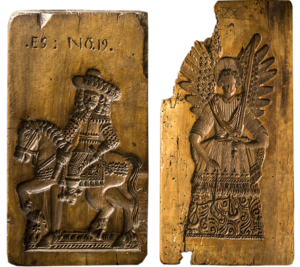
Puust piparkoogivormid Toruni piparkoogimuuseumis Poolas. Muzeum Toruńskiego Piernika
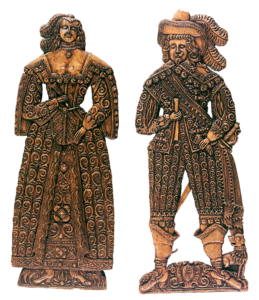
17-18. sajandist vormidega valmistatud kuninglikud piparkoogid Cesky Krumlovi ajaloomuuseumis, Tšehhis. Cesky Krumlovi Ajaloomuuseum
Erikujulised maiustused
Piparkookide välimusele ja sümboolikale on läbi ajaloo erilist tähelepanu pööratud. Nad on alati olnud erikujulised ja pilkuköitvad. Piparkoogid olid oma aja uudiste edastajad, kujutades uute kuningate, imperaatorite või kuningannade portreesid. Need olid omamoodi tänapäeva ajakirjade ja kunstiraamatute eelkäijad. Hoolikalt kujundatud piparkoogid olid ainus „graafiline disain”, mis jõudis tavaliste inimesteni. Kloostrites valmistati usulist sümboolikat kandvaid vürtsikooke. Piiblistseene, pühakuid ja kroonitud päid kujutavaid koogikesi söödi mitmesuguste pühade ajal ning müüdi palveränduritele.
Piparkookide kaunistamise tarvis töötasid eraldi kunstnikud, kes ilustasid küpsetisi kullatise, hõbeda, peegli- ja klaasikildudega ning maalides neile pilte. Kaunistustega reljeefseid piparkooke valmistati spetsiaalsest tugevamast kergitusaineteta taignast. Neid piparkooke ei söödud kohe, vaid nendega kaunistati eluruume ning pandi lauale pidulikel söömaaegadel. Need olid omamoodi jõukuse sümbolid. Neid piparkooke hoiti aastaid. Mittesöödavad koostisosad hiljem siiski keelustati, sest ka kaunistatud piparkoogid leotati pehmeks ja pisteti lõpuks nahka. Peegleid võib ka näha tänapäeval näiteks Ungari käsitööpiparkookidel.
Pagarid kasutasid puust nikerdatud vorme, mis olid tavaliselt kuni 25×15 cm suurused. Vormide graveerimiseks kasutati peenekiulisi puid: pärn, kask, õun, pirn, kirss ja vaher. Harvem tehti vorme ka savist või lubjakivist. Metallist piparkoogivorme hakati kasutama alles 18. sajandil. Kasutati ka kombinatsioone, kus puuvormiga vajutati taignale reljeefne kujutis ning metallvormiga lõigati piparkook taignast välja. Peale küpsetamist kaunistati piparkook värvi, glasuuri või isegi kullatisega. Tänapäeval on reljeefsete kujutistega piparkoogid unustusse vajunud. Siiski on üksikutes maades alles jäänud väiksemad kujutistega piparkoogid: Saksamaal springerled, Hollandis ja Belgias spekulaasid.
Piparkoogi maagilised ja ravivad omadused
Piparkookidel on alati usutud olevat maagilised ja ravivad omadused. Näiteks usuti, et soldatite, relvade ja kindlusetaoliste piparkookide kinkimine kasvatab vaprust ja julgust. Mehe ja naise kujutamine küpsetiste vormis lisas abieluõnne, piparkoogist süda viitas armastusele. Piparkoogist südame kinkimist väljavalitule võrdsustati armastuskirjaga. Vallalistele naistele kingiti piparkoogist meesfiguure, et nad leiaksid perekonnaõnne. Tuvi loeti kiindumuse sümboliks, küülik tähendas sigivust, isahirv sümboliseeris vaprust ja siga küllust.
Ka on ajaloost teada, et 1497-1501 Rootsi, Norra ja Taani aladel valitsenud kuningas Hansule määras arst kurvameelsuse raviks just piparkooke. Sageli küpsetasid piparkooke nunnad ning neid müüdi apteekides mitmesuguste hädade raviks.
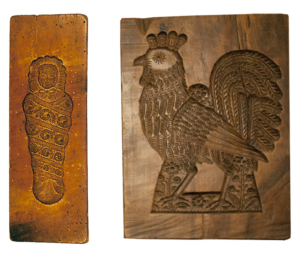
Kukk oli üldise hea õnne sümbol. Beebikujuline piparkook pidi tooma lapseõnne.
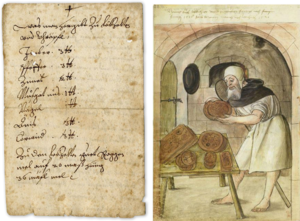
Piparkoogiretsept 17 saj Saksamaalt (Archdiocese Munich) ja piparkoogimeister u 1520 (Stadtbibliothek Nürnberg)
Väärtuslikud ja salajased koostisosad
Keskajal olid piparkookide valmistamise põhitooraineteks jahu, mesi ja vürtsid. Kuni 18 sajandi lõpuni said piparkooke endale lubada vaid rikkamad linnakodanikud. Alates 19 sajandist asendati mesi odavama suhkrusiirupiga, mis tegi piparkoogid kättesaadavaks ka lihtrahvale. Piparkoogitaignas olid kasutusel vürtsid — kaneel, kardemon, muskaatpähkel, koriander, nelk, ingver, vürts, pipar, aniis, apelsini- või sidrunikoor, hakitud pähklid. Piparkoogiretseptid olid hoolikalt valvatud saladused, mida anti põlvest põlve edasi. Samuti pärandati hinnalisi puust vorme.
Piparkookide retseptid ja traditsioonid varieeruvad eri maades. Piirkonniti olid koogid pehmemad ja paksemad, kohati õhukesed ja krõbedad. 12. saj. valmistati Inglismaal piparkooke meest, vürtsidest ja leivapurukestest, mida ei küpsetatud, vaid vormiti ja lasti seista. Kasutati erinevaid retsepte söödavate ja kaunistuspiparkookide jaoks.
Euroopa piparkoogipealinnad
Õhukeste ja krõbedate piparkookide poolest on tuntud Saksamaa. Ülemaailmset kuulsust kogusid Saksa Pulsnitzi linna pagarid, kes said aastal 1558 loa hakata valmistama kohaliku retsepti järgi erilisi piparkooke ehk Pfefferkuchen’eid. Pulsnitzi linna nimetatakse rahvasuus tänini piparkoogilinnaks e. Pfefferkuchenstadt. Maailma piparkoogipealinnaks peetakse aga Nürnbergi. Seal andsid panuse parimate piparkookide sünniks skulptorid, maalijad, graveerijad ja kullassepad. Nende valmistatud piparkooke, mis kujutasid ingleid, südameid ja pärgasid, peeti tõelisteks kunstiteosteks. Nürnbergi piparkookide (Nuremberg Lebkuchen) põhilisteks koostisaineteks olid mesi, vürtsid ja apelsinikoor ning glasuuriks pruun šokolaad. Saksamaalt on pärit ka kuulsad piparkoogimajad, mille ehitamise traditsioon sai alguse populaarsest muinasjutust „Hänsel und Gretel” („Hansuke ja Greteke”). Majaehitamise vaimustus levis koos saksa väljarändajatega Põhja-Ameerikasse, kus piparkoogimajade ehitamisest sai oluline osa sealsest jõulutraditsioonist. Põhja-Ameerikas toimub tänapäeval kõige rohkem piparkoogimajade näitusi ja konkursse.
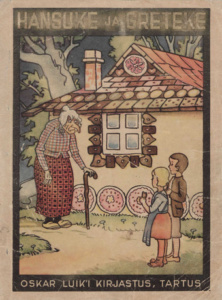
1934 ilmunud esimene eestikeelne vendade Grimmide muinasjutt Hansuke ja Greteke
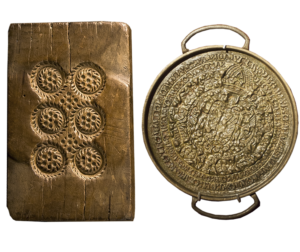
Puust ja metallist piparkoogivormid Toruni piparkoogimuuseumis Poolas. Vasakul Toruni kuulsaim piparkoogikujund – Katarzynka.
Nürnbergi kõrval on ka teine linn — Torun Poolas —, kus valmistatud piparkoogid on olnud sajandeid maailmakuulsad. “Pierniki torunskie “ on Poola piparkoogid, mida on valmistatud selles keskaegses hansalinnas juba üle 700 aasta. Torunis olid kõik eeldused vürtsikookide kultuuri tekkeks — hästi arenenud mesindus, viljakas maa ja linna läbiv kaubatee. Linna jõudsid vürtsid Indiast. Esmakordselt mainitakse Toruni piparkooke 1380. aastal. Piparkoogimeistrid ei olnud ainsad, kes neid delikatesse valmistasid — 16. saj. oli piparkookidega kaubitsemine sealse Tsistertslaste ordu üheks peamiseks jõukuseallikaks. Kuna piparkook oli tänu vürtsidele üks väheseid hea säilivusega küpsetisi, müüdi neid edukalt ka väljaspoole riigipiire. 17. saj. soosisid linnavõimud tulusat piparkookidega kauplemist, tehes maksusoodustusi vürtside sisseveole ning toetades pagarite tsunfte piparkookide eksportimisel.
18-19. saj. toimus massiline pagaritöökodade sulgemine seoses tööstusliku tootmise juurutamisega. Aastaks 1825 oli linnas alles vaid kolm traditsioonilist pagaritöökoda. Ent sellele vaatamata ei vähenenud Toruni piparkookide tuntus ja kohaliku ajalehe 1875. aastal ilmunud väljaandest võib lugeda, et Toruni piparkooke eksporditi sellel aastal isegi nii eksootilistesse paikadesse nagu Aafrika, Türgi, Jaapan, Hiina ja Hawaii saared. Toruni piparkooke on ülistatud nii kirjanduses kui ka kaunites kunstides. Neist on sageli juttu Poola legendides ja vanasõnades. Ühe legendi järgi on piparkook mesilaste kuninganna kingitus inimkonnale. Traditsiooniliselt on Toruni linn piparkooke kinkinud Poola silmapaistvatele kultuuri- ja poliitikategelastele, Poola kuningatele ja isegi Napoleonile. Suurim ja kuulsaim Toruni piparkook valmistati aastal 1778. 2 meetrit pikk ja 30 cm lai hiidpiparkook oli kingitus Katariina Suurele.
Ungaris mainivad kirjalikud allikad piparkookide valmistamise kunsti esmakordselt 14. sajandil, kus keskaegse ühiskonna ülemkihtides pakuti või kingiti piparkooke pereliikmetele ja külalistele. Säilinud puidust nikerdatud piparkoogivormidelt on näha, et koogid kujutasid enamasti kas piiblimotiive või valitsejate vappe ning portreesid. 17. saj. teisel poolel hakati Ungaris looma Lääne-Euroopa eeskujul piparkoogimeistrite tsunfte. 18. saj. piparkoogid olid kaunistatud rohkem linnakodanike maitsele vastavalt. Religioossed kaunistusmotiivid jäid tagaplaanile, populaarseteks kujunditeks said uhkesti riides mehe- ja naisekujud, teki sisse mähitud titt, süda, hussaar hobusel, mõõk jms. 19. saj. algul muutusid piparkoogid ka Ungari talupoegade seas populaarseks. Piparkoogimeistrid müüsid oma kaupa turgudel, laatadel ja kirmastel, neid osteti mälestusesemeks või kingituseks. Enamasti neid ei söödudki, vaid hoiti küla tänavapoolsel aknal uhkuseasjana alles niikaua kui võimalik. Tänapäeva Ungaris küpsetatakse rikkalikult kaunistatud piparkooke ka lihavõteteks. Pulmade puhul tehakse sageli noorpaarile kingituseks piparkoogipuu, kus igal elemendil on sümboolne tähendus. Veel 20. sajandi keskpaiku on pulmadeks kingitud hiigelsuuri kaunistatud piparkoogisüdamed.
Piparkoogitegemine oli tuntud ka Tšehhis. Näiteks mainitakse Cesky Krumlovi linna ürikutes aastal 1617 kohalikku piparkoogimeistrit Jakub Prunnerit. Sealsest ajaloomuuseumist võib leida rohkelt barokseid mitmesuguste sümboolsete kujunditega puidust piparkoogivorme. Tuntuimad piparkoogikeskused Euroopas olid Lyon, Nürnberg, Basel, Pest, Praha, Pardubice, Pulsnitz, Ulm, Torun.
Piparkookide retseptid ja traditsioonid varieeruvad eri maades. Piirkonniti olid koogid pehmemad ja paksemad, kohati õhukesed ja krõbedad. 12. saj. valmistati Inglismaal piparkooke meest, vürtsidest ja leivapurukestest, mida ei küpsetatud, vaid vormiti ja lasti seista. Kasutati erinevaid retsepte söödavate ja kaunistuspiparkookide jaoks.
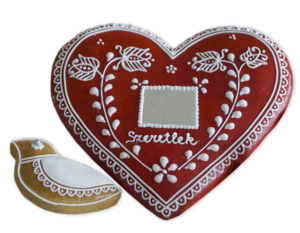
Ungari piparkoogimeistri Klara Repas’e piparkoogid
Piparkoogid Eestis
Eesti piparkoogi ajaloo uurimisega tegeleme praegu aktiivselt ja sellega seoses ootame piparkookidega seotud põnevaid mälestusi ja lugusid. Samuti oleme väga huvitatud vanadest piparkoogivormidest, retseptidest, rullidest ja muudest teemaga seotud esemetest.










